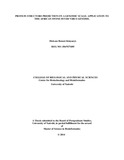| dc.description.abstract | Pork is widely consumed worldwide. One potential threat to food security is ASFV (African Swine Fever Virus), the etiological agent of ASF (Africa Swine Fever) in pigs. To date there is no known vaccine for this disease that is characterized by 95-100% mortality rate and frequent outbreaks. The study aimed at predicting protein structures of the 83 unpredicted ORFs in ASFV because of the low sequence identity. I-TASSER an integrated platform that uses low sequence identity is used for protein structure prediction. It combines abinitio folding and template-based modeling for genome-wide structure prediction. The study managed to identify an essential protein for the survival of ASFV in stressful environments. The identified protein, H171R, is predicted to belong to the ferritin group and is essential for survival of the virus in the macrophages. Of the 83 uncharacterized proteins in ASFV ORFs, I-TASSER generated models with an average TM-score of 0.7185. TM-Score is a quantitative criterion for structure classification, if it is greater than 0.5 protein structures are classified to belong to the same class. SCOP (Structural Classification of Proteins), a manual based fold classification system for proteins was unable to classify 56% of PDB101 experimentally solved structures we used as templates.TM fold classified 99%. NetMHCIIpan3.0 identified viral peptides that bind to Swine Leukocyte Antigen. This may be useful for vaccine development. In conclusion, the study of ASFV proteins, represent promising progress towards genome-wide structure modeling and fold family assignment when the sequence homology is less than 20%.We identified an immunogenic protein H171R, a protein previously uncharacterised, and found it is a strong binder to Swine Leukocyte Antigen-DQ, hence it should be considered as a vaccine candidate. | en_US |

